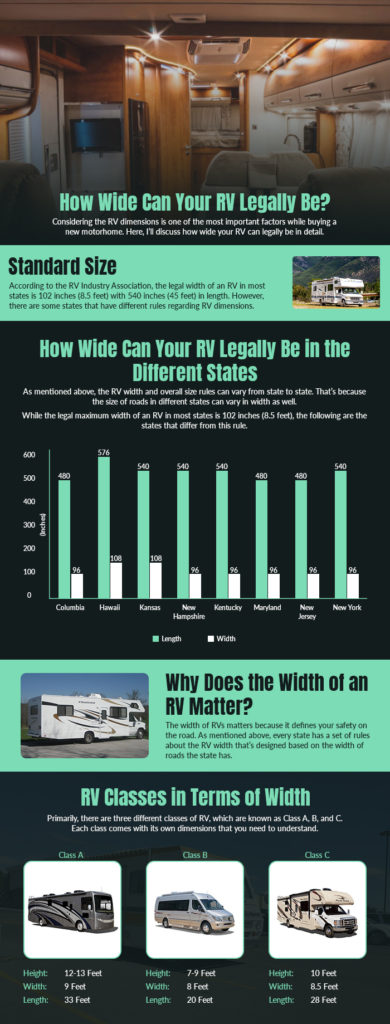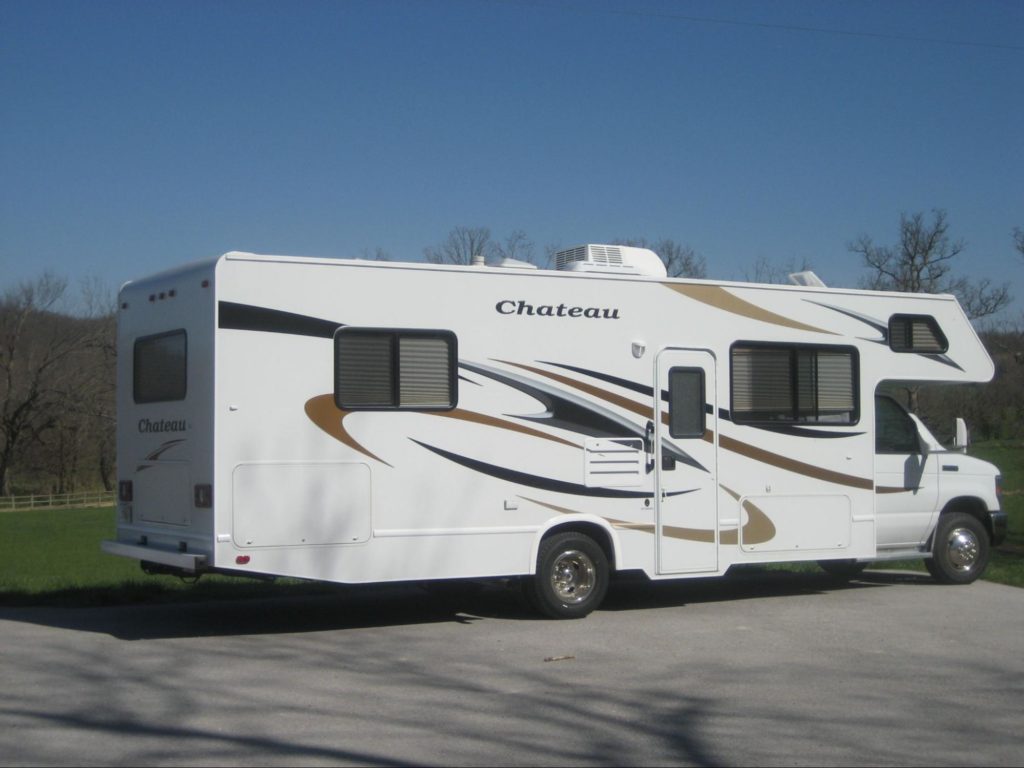Hi-van is supported by its audience. When you purchase using our links, we may earn an affiliate commission (no added cost to you). Learn more
There are several factors that you must keep in mind when investing in a new RV or exploring used motorhomes. Along with dependability, fuel economy, safety function, and comfort features, you must also consider the dimensions, especially the width of the vehicle.
It not only means that you should get the most space and size for your investment but it also means that you don’t cross legal boundaries.
Typically, RVs are built between 96 and 102 inches wide, which is approximately 8 to 8,5 feet. Federal road regulations dictate that no RV should be wider than 8.5 feet.
However, it’s crucial to note that width restrictions may vary from state to state, with some areas limiting RVs to only 8 feet or others having a maximum of 9 feet.
To avoid any legal issues or difficulties during your travels, it’s a good idea to familiarize yourself with the specific width restrictions in the states you plan to visit. Double-checking these requirements ensures a smoother and more enjoyable RV experience, and it will help you confidently navigate your way through your road trip adventures.
In this article, I’ll discuss everything you need to know about RV dimensions, especially width. I’ll help you understand what width size you should choose while buying a motorhome depending on your state.
Legal RV Width Limits in the United States
In the United States, the legal width limit for RVs varies depending on the state.
While some states allow a maximum width of 8 feet 6 inches (102 inches), others can permit widths up to 9 feet.
To ensure you stay compliant with your RV’s width, it’s essential to know the regulations in the states you’ll be traveling through.
State-by-State Regulations
Most states have set a legal limit of 8 feet 6 inches (102 inches) for RVs on the road.
However, there are some exceptions to this rule. For example, Hawaii is the only state with a 9-foot width restriction. Additionally, certain states enforce an 8-foot maximum RV width. Be sure to check the regulations for each state you plan to travel through.
It’s also important to remember that legal width limits for RVs may differ slightly on federally funded roads. On these roads, including interstate highways, you’re typically allowed to have an RV up to 8.5 feet wide. However, be aware that these roads must have a minimum lane width of 12 feet.
If you own a motorhome, keep in mind that the same width regulations apply. It’s always a good idea to measure your RV before hitting the road to ensure it falls within the legal width limits.
In summary, knowing the legal RV width limits for each state you plan to visit is crucial for a worry-free trip. Keeping your motorhome within these limits will help you avoid potential fines and ensure a safe journey.
District of Columbia
- Maximum allowed width: 96 inches or 8 feet
- Maximum allowed length: 480 inches or 40 feet
Hawaii
- Maximum allowed width: 108 inches or 9 feet
- Maximum allowed length: 576 inches or 48 feet
Kansas
- Maximum allowed width: 108 inches or 9 feet
- Maximum allowed length: 540 inches or 45 feet
New Hampshire
- Maximum allowed width: 96 inches or 8 feet
- Maximum allowed length: 540 inches or 45 feet
Kentucky
- Maximum allowed width: 96 inches or 8 feet (102 inches or 8.5 feet on certain federal roads)
- Maximum allowed length: 540 inches or 45 feet
Maryland
- Maximum allowed width: 96 inches or 8 feet (102 inches or 8.5 feet on certain federal roads)
- Maximum allowed length: 480 inches or 40 feet
New Jersey
- Maximum allowed width: 96 inches or 8 feet (102 inches or 8.5 feet on certain federal roads)
- Maximum allowed length: 480 inches or 40 feet
New York
- Maximum allowed width: 96 inches or 8 feet (102 inches or 8.5 feet on certain federal roads)
- Maximum allowed length: 540 inches or 45 feet
Other than roads in Washington DC, all federally funded roads in the country, like interstate highways, allow for RV with 102 inches or 8.5 feet of width. However, these roads must have at least 12 feet wide lanes.
Check fifthwheelst.com for the complete list. Furthermore, if you want to be off-grid in your RV, we also made a list of the states you shouldn’t go to.
Factors Affecting RV Width
Types of RVs

When determining the legal width of your RV, it’s essential to consider the type of RV you have.
For instance, motorhomes typically have a maximum width of 8.5 feet (or 102 inches) due to federal road regulations. However, there can be differences in width depending on the class of motorhome – Class A, Class B, or Class C. The width of trailers can also vary, with some, like fifth-wheel trailers, potentially exceeding the legal limit when including slide-outs.
Customizing Your RV
Customizing your RV can also affect its overall width. Additions such as awnings, side mirrors, or extra safety equipment might extend the RV width beyond the legal limit. Be mindful of these customizations when measuring your RV’s wideness to ensure it stays within the maximum legal limit of 102 inches (8.5 feet) in most states.
Safety Considerations
It’s crucial to prioritize safety when considering your RV’s width. When traveling in your RV, ensure that it complies with the legal dimensions of each state you will be driving through. Check for any tight restrictions that might be in place in your destination states to avoid any possible legal issues on the road.
Additionally, be aware of potential stability concerns with wider RVs. These may include difficulties navigating narrow roads or maintaining proper balance when towing a wide trailer. Always prioritize safety and follow all state and federal regulations pertaining to RV width for a smooth and enjoyable journey in your motorhome or trailer.
International RV Width Regulations
There are varying width regulations for recreational vehicles (RVs) around the world. To help ensure your RV meets width requirements in different countries, this section will discuss the limits in Canada and Europe.
Canada Limits

In Canada, the maximum permitted width for an RV is generally 8 feet 6 inches (102 inches). This standard applies nationwide, making it easier to travel across provinces with your RV. Be sure to verify the legal dimensions of your RV, which often exclude mirrors and other safety equipment.
Europe Regulations

RV width regulations in Europe can vary significantly. In European Union (EU) countries, the maximum legal width for an RV is typically 2.55 meters (100.4 inches). However, non-EU countries may have different width restrictions, so always check local regulations when traveling with your RV.
Understanding these international width limits will help ensure your RV complies with regulations in various destinations. Keep aware of these limits when planning your trips, and always check local rules for the most up-to-date information.
Planning an RV Route
When planning your RV route, you need to make sure your RV width complies with state laws. Most states in the U.S. have a maximum RV width of 8 feet 6 inches. However, some states allow up to 9 feet, while others limit it to only 8 feet. To avoid any legal issues, research the width restrictions for the states you plan to travel through.
Consider the dimensions of your RV when selecting an appropriate campground or RV park. Keep in mind that some sites might have limited space for wider RVs. Make sure you measure the full width of your RV, including slide-outs, as these might require an additional 6 to 8 feet of space.
To simplify route planning, you can use specialized RV GPS systems such as Rand McNally GPS, which takes into account RV rules and regulations during navigation.
Garmin also makes a easy to use GPS designed specifically for RV users: The Garmin RV 785
Obtaining Special Permits if Needed
If your RV exceeds the legal width limits for a specific state, you might need to obtain an oversize permit to travel through that state. Keep in mind that extra-wide vehicles might also require escort vehicles and additional safety measures.
To obtain a permit, you will need to provide details about your RV, such as its dimensions and the specific route you plan to take. Check the transportation department’s website for the relevant state to find guidance on obtaining a permit and follow the appropriate steps.
Remember to plan your trip in advance to accommodate for the extra time needed to obtain a permit and any potential restrictions on when wide vehicles can travel on certain roads.
Frequently Asked Questions
Max width for RV on roads?
Most states in the US have a legal maximum width of 102 inches (8.5 feet) for RVs on the road. However, some states may have tighter restrictions, such as Hawaii, which has a 9-foot width limit. Be sure to check the regulations in each state you plan to drive through with your RV.
Class A motorhome width?
Class A motorhomes, which are typically the largest and most luxurious type of RV, can be up to 8.5 feet wide, which is the maximum legal width in most states. This width allows for spacious interiors and plenty of amenities but may require some adjustment if you’re accustomed to driving smaller vehicles.
Class C motorhome width?
Class C motorhomes are a popular choice due to their versatility and convenience. They usually fall within the 96 to 102 inches (8 to 8.5 feet) width range which is compliant with the legal width limit in most states.
Class B motorhome width?
Class B motorhomes, also known as camper vans, are generally the most compact and easy to maneuver. Their widths are typically around 6 feet or 7.5 feet wide and are well within the legal width limits. This smaller size can make them ideal for travel in urban areas or through narrow roads.
Width with slides extended?
Keep in mind that the legal width of your RV does not account for slide-outs, which expand your RV’s living space when parked. When getting set up at your campsite or RV park, it’s crucial to ensure that your expanded width does not infringe on neighboring lots or create an obstacle in the surrounding area.
Dimensions for large RVs?
Large RVs, including some Class A and Class C motorhomes, can have lengths up to 540 inches (45 feet). Nevertheless, it’s essential to remember that the legal width limits still apply, and you should ensure that your RV complies with the restrictions in each state you plan to visit.
Why Does the Width of an RV Matter?
The width of RVs matters because it defines your safety on the road. As mentioned above, every state has a set of rules about the RV width that’s designed based on the width of roads the state has.
If you use a recreational vehicle that is wider than the rules defined, it’ll increase the risk of damaging other vehicles on the road. Additionally, if your motorhome is too wider, it can even get damaged by buildings around it.
The width of your motorhome also matters because it affects the turning radius of the vehicle. The wider the RV the higher the turning radius. It means that you’ll get stuck on tight corners and turns if your vehicle is too broad.
How to Measure the RV Width
You want to make sure that the width of your RV complies with the rules set by your state. Otherwise, you won’t be able to get it registered with your state’s Department of Motor Vehicles.
The width of a recreational vehicle is measured from one side to the other of the widest part. However, as mentioned earlier, the appurtenances aren’t included while measuring the width.
You can use a simple tape measure to complete this process easily. However, if you can’t measure your motorhome’s width, you can read the user manual of the vehicle.
It’ll allow you to find out the exact measurement if you have not performed any modifications to your RV that have altered the width.
Final Words
Considering the width of an RV while buying a new motorhome is very important. It’ll allow you to choose the vehicle that doesn’t break any laws and gives you a safe driving experience.
I hope this guide has helped you understand what width size you should consider while buying an RV depending on your State/area.
Infographic





